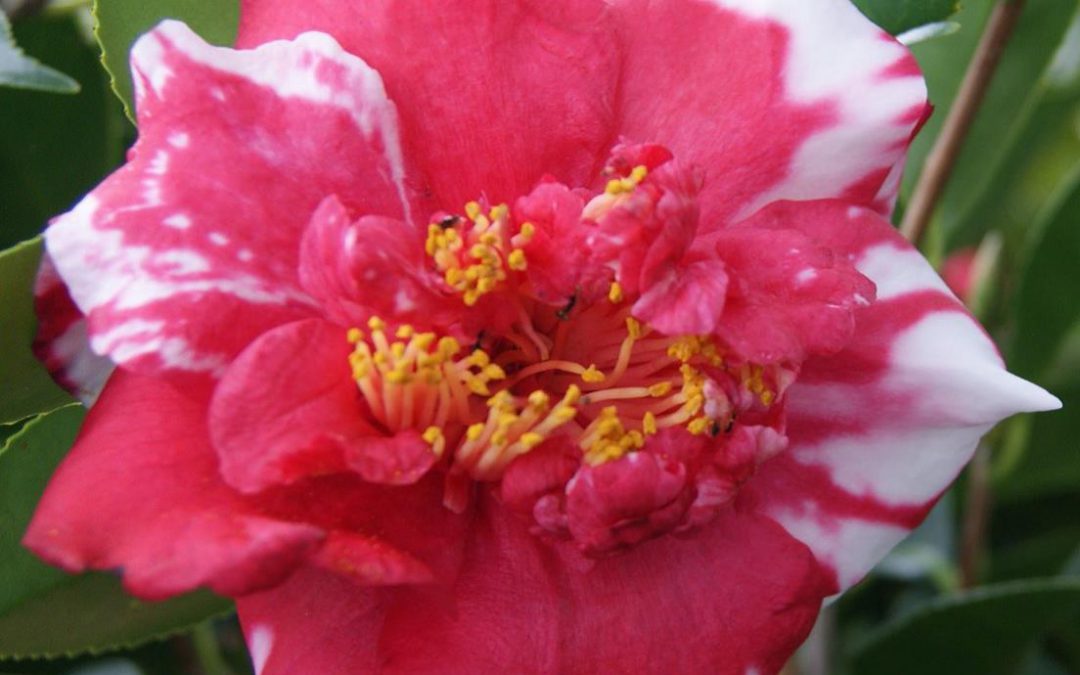
by Matthew Orwat | Jan 14, 2014
Want to learn how to graft Camellias?
Graft your favorite cultivar onto an adapted rootstock!
Saturday January 18th 9:00am – 12:00pm CST !
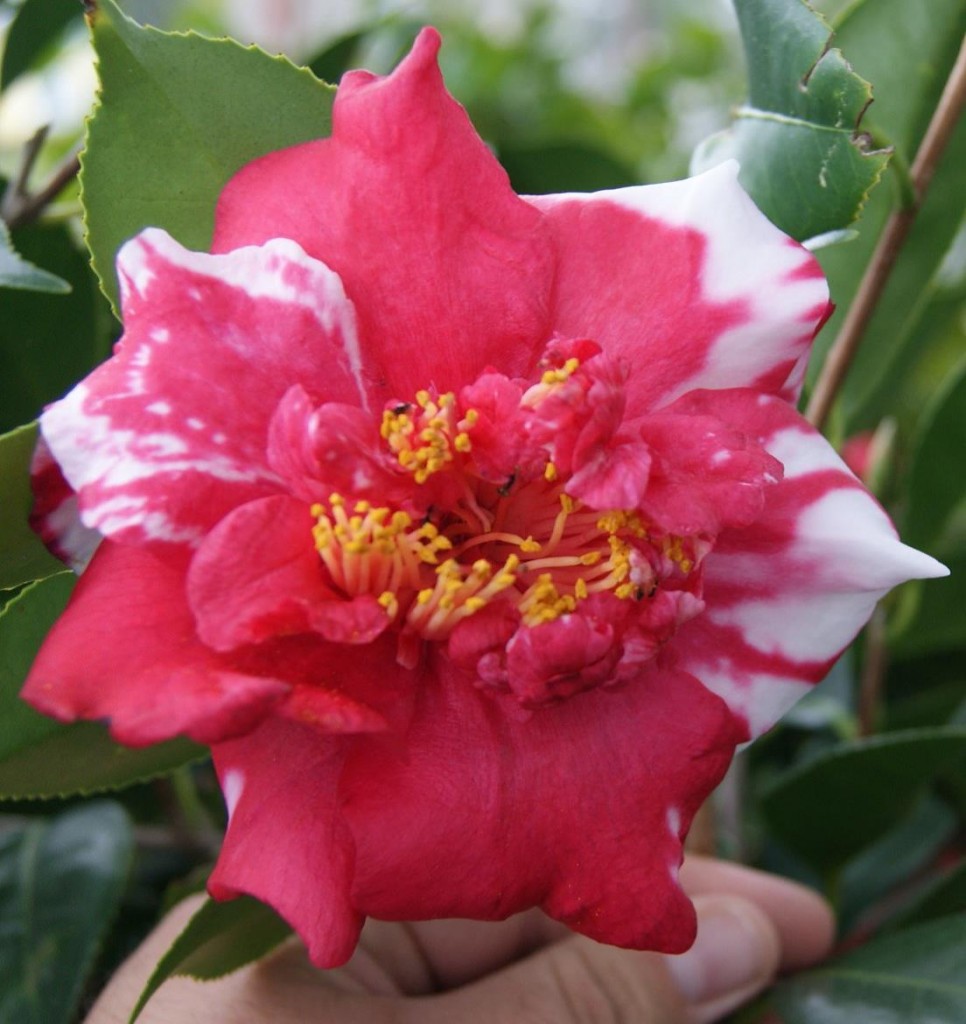
- Join us to learn how to graft your favorite camellia cultivar onto an adapted rootstock
- You can take home your own grafted camellia
- Hosted by Maphis Tree Farm and UF IFAS Extension Washington County
- You will engage in hands on grafting of Camellias for your gar-den. You will take home a grafted Camellia of your own All sup-plies will be furnished by Maphis Tree Farm at a cost of only $30.00 per person
- Maphis Tree Farm 1534 orange Hill Hwy Chipley, FL.
- Call or Email Maphis Tree Farm toregister at 850-638-8243
 maphistreefarm@bellsouth.net
maphistreefarm@bellsouth.net

by Carrie Stevenson | Jan 14, 2014
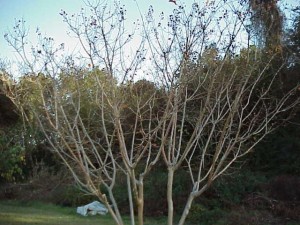
The branching structure of crape myrtles makes an impact to landscapes even in winter time. Photo credit: Beth Bolles
Most people associate yard work with the spring and summer, but if you’re considering a major redesign of a home landscape, now is a great time to start. Without the vegetation on deciduous trees, it’s easy to see the “bones” of your yard—the tree trunks and branches, sidewalks, and fences—which frame it.
One of the best ways to start with landscape design is a piece of paper and pencil. If you’ve got a paper copy of your survey, even better—you can sketch in trees, sidewalks, and fences with an aerial view and see where the open spots lie. Take some time to walk around your yard, considering how you use the space. Do you have children or pets that need room to run? A shady area for relaxing? Full sun for a garden? All of these uses can co-exist in a single yard, but the key to good landscape design is allowing for them to flow together in a logical, attractive way.
If you’ve never put together a comprehensive landscape design before, there are several very helpful tools online provided by horticulture experts with UF IFAS Extension. The “pattern guide” is ideal for starting and completing small projects, such as side yards, shade areas, etc. and even suggests appropriate plants based on light conditions and region of the state. Using this guide is a great way to start from scratch and build up to a diverse, healthy landscape. On the other hand, if you are essentially satisfied with your yard but just need a few accent plants or another tree somewhere, a great online resource is http://deactivated_site/. Here, you can enter a set of specific criteria based on the type of plants you’re looking for, and the site will create a customized list of suggestions to use in your landscape.

The online Florida-friendly landscaping pattern book has great ideas for redesigning your landscape.
After deciding on additional needs for hardscape and plantings, the next step is to make room for them by removing sod or unwanted landscape plants. Now is also the time to look at irrigation needs—if you have an existing system, make sure it still works with your new landscape design. If it doesn’t, it’s much better to redirect water, piping, or add new sprinkler heads while you’re digging into the soil than after you’ve finished installing new vegetation. If you aren’t using an irrigation contractor, you’ll need a solid understanding of how the system is set up before making changes. Inexpensive kits can also be purchased to add drip or micro-irrigation to an already-installed system.
Once irrigation and hardscape are complete, you can begin with plant installation. It makes the most sense to plant trees first, add mulch around the root zone, then put in shrubs and groundcovers based on your plan. Many do-it-yourselfers will take their time on this step, adding new plants as time and budget allow. This method works well and can be a fascinating way to watch your yard transform.
We have many great resources for more in-depth discussion of landscape design and irrigation work, including your local UF IFAS Extension office. Don’t hesitate to call us with questions or send photos of your new and improved yards!
by Gary Knox | Jan 7, 2014
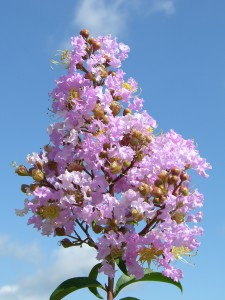
‘Apalachee’ has light lavender flowers. Photo by Gary Knox
‘Apalachee’ crapemyrtle is a statuesque small deciduous tree with lavender flowers, dark green leaves and cinnamon-orange bark. Lagerstroemia indica x fauriei ‘Apalachee’ is one of the hybrids released in 1987 from the breeding program of the U.S. National Arboretum. It grows as an upright to vase-shaped, multi-stemmed tree in USDA Cold Hardiness Zones 7a-9b.
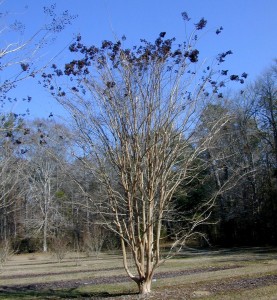
Seed capsules of ‘Apalachee’ add winter interest. Photo by Gary Gnox
Seed capsules add unexpected winter ornament to the leafless branches of the deciduous tree. Because individual flowers are packed tightly in the flower panicle, the seed capsules are correspondingly closely spaced. Persisting seed capsules add interest to the tree’s profile similar to the way dried flowers of oakleaf hydrangea continue to add interest long after the flowers have faded.
Crapemyrtle grows and flowers best in full sun with rich, moist soil but is tolerant of drought and all but wet soils. ‘Apalachee’ has good resistance to powdery mildew, very good resistance to cercospora leaf spot and moderate resistance to flea beetle (Altica sp.). This hybrid is susceptible to crapemyrtle aphid. ‘Apalachee’ performs best with minimal pruning. Crapemyrtle is best located away from pavement and structures that may be stained by fallen flowers.

Cinnamon-orange bark of ‘Apalachee’. Photo by Gary Knox
‘Apalachee’ grew to a height of 26 feet and a width of 21 feet in 15 years at former University of Florida facilities in Monticello, Florida. It was one of the most outstanding crapemyrtles in that evaluation planting. This crapemyrtles’ form, vigorous growth, dark green leaves, lavender flowers, cinnamon-orange bark, and persistent seed capsules give it year-round appeal and allow it to stand out among crapemyrtle cultivars.
Lagerstroemia indica x fauriei ‘Apalachee’ has not yet been evaluated using the IFAS Assessment of Non-Native Plants in Florida’s Natural Areas. Without this assessment, the temporary conclusion is that Lagerstroemia indica x fauriei ‘Apalachee’ is not a problem species at this time and may be recommended.
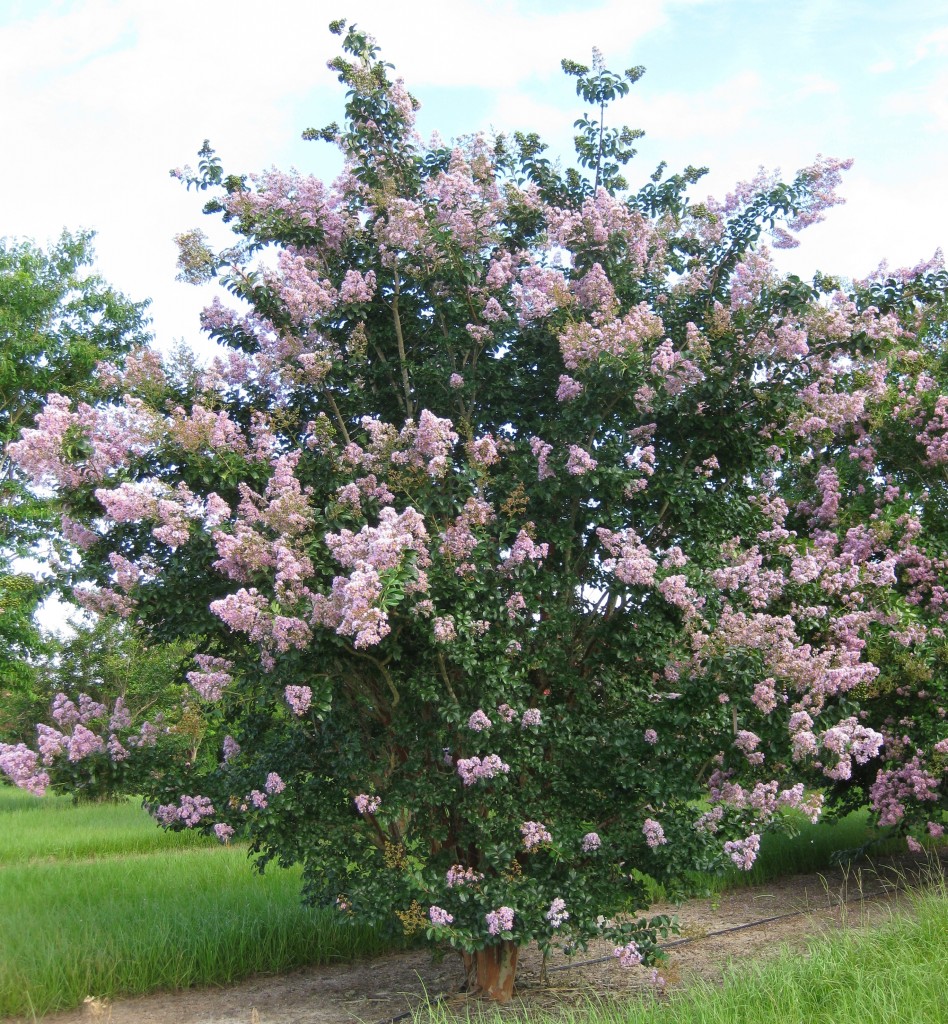
‘Apalachee’ crapemyrtle in full bloom. Photo by Gary Knox
by Blake Thaxton | Sep 23, 2013
It has been a hot summer but Fall is right around the corner. Cooler temperatures and changing colors are a welcomed change in the panhandle of Florida. Fall can be a great time to spruce up your landscape with some new shrubs.
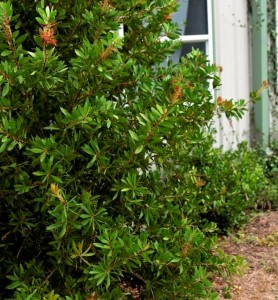
Image Credit UF / IFAS
It may be time for your landscape to receive a mini-makeover and to get a new look for fall and years to come. Perhaps some shrubs strategically placed will be what makes your outdoor living space pop. Proper selection and installation is key to health of the shrub moving forward.
Selection
There are several factors that need to be taken into account before buying shrubs to add to your landscape. Carefully selecting plants based on the following points will help with long term success of the plant:
- Climate – Be sure that the species will tolerate the climate you live in.
- Environment – Study the light level, acidity, and drainage of the planting site.
- Space – Account for the mature size of the plant before planting. This will keep you from having to remove the plant if the space is not adequate.
- Inspect the plant – Check for mechanical injury (scars and open wounds), cold injury, condition and shape of the canopy, and examine the root system.
Installation
Now that the proper plant has been selected it is time to give the shrub the best chance for survival with proper installation techniques. Fall and winter is an ideal time for planting shrubs. The roots can develop before the tops begin to grow in spring. The following are the keys to proper establishment of container shrubs.
- Root ball preparation – Remove the container from the root ball and inspect for circling roots. If there are circling roots than make three or four cuts vertically to cut the roots. Pull some of the roots away so they will take on a new growth direction (massage the roots). Also find the top most roots as sometimes they are covered by extra potting media. Remove the extra potting media so the top most roots are exposed and become the top of the root ball.
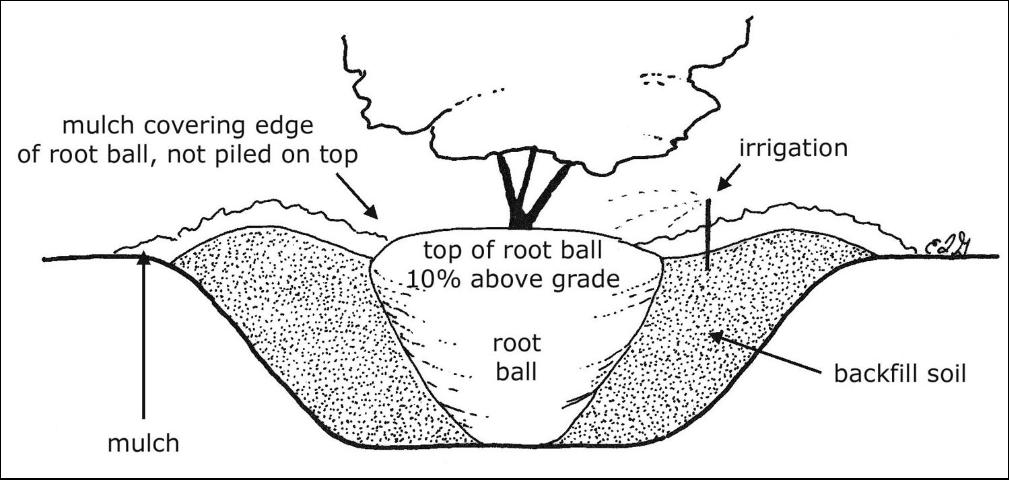
Image Credits: UF/IFAS, Edward F. Gilman
- Wider is better – Dig the hole two or three times the diameter of the root ball.
- Proper depth – Make sure to dig the hole 10% less than the height of the root ball. In poorly drained soils dig the hole 25% less than the the height of the root ball. The top most roots should be slightly above the native soils.
- Backfill – Fill the hole with existing soil half way and tamp the soil to settle. Again fill the rest of the hole with the existing soil and tamp again to settle the soil. Do not place any backfill soil or mulch over the root ball as it is crucial that water and air are able to be in contact with the the roots.
- Aftercare – Irrigate daily for the first two weeks, followed by every other day for the next two months, and weekly until the shrub is established (For <2 inch caliper shrubs).
If these key points are followed regarding selection and installation, the shrubs will be well on their way to becoming established in the landscape. If you would like read more in detail about installation please read the following:
Specifications for Planting Trees and Shrubs in the Southeastern U.S.
Literature:
Gilman, E.F., (2011, August) Specifications for Planting Trees and Shrubs in the Southeastern U.S.. Retrieved from: http://edis.ifas.ufl.edu/ep112
Black, R.J. and Ruppert, K.C., (1998) Your Florida Landscape, A complete guide to planting & maintenance. Gainesville, FL: University Press of Florida.
by Mary Salinas | Sep 23, 2013
Is the newest growth on your sago palm turning yellow, brown, frizzy looking and dying – is it a pest or disease or something else?
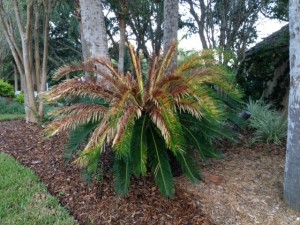
Photo credit: Mary Derrick
This sago palm is suffering from a classic case of manganese deficiency. When sago palms lack manganese, the newest leaves will develop yellow splotches or be entirely yellow. As the leaves die, they turn brown and take on a frizzled appearance. Sometimes the leaves or fruit may be smaller than normal. If left unchecked, the sago usually dies.
Manganese is a micronutrient required by all plants for normal, healthy growth and is most available for plant uptake when the soil pH is between 5.5 and 6.5. Soils in the Florida panhandle are often naturally low in manganese and then what available manganese is present can be unavailable for the plant to use if the pH of the soil is much above 6.5. Also, manganese tends to be leached from the soil when the pH is below 5.5. Soil pH and nutrient testing is useful to determine if soils are nutrient deficient. Contact your county Extension office for information on getting that done.
[notice]Before treating, rule out an infestation of Asian cycad scale. Click here for a UF IFAS Extension publication on this damaging insect. Be aware that both are common problems for sago palms and that your sago may be afflicted with both![/notice]
If this is happening to a sago palm, the good news is that it is easy to correct. Manganese sulfate is readily available at garden centers, feed &seed stores and independent nurseries. Just make sure to get manganese sulfate and don’t confuse it with magnesium sulfate (Epson salts). The amount of manganese sulfate necessary to correct this deficiency will vary with its size, soil type and pH. Sago palms in sandy, acidic soils require less manganese sulfate than those in high pH soils. One ounce is sufficient for a very small plant in sandy, acidic soil. A very large sago in a high pH soil may require about five pounds, however. Spread the product evenly over the root zone and water in with about a half inch of water.
The affected leaves cannot be cured but new growth should return to normal. If the new growth is still affected, an additional application of manganese sulfate may be needed. Once sago palms have suffered from a manganese deficiency, half the initial rate should be applied yearly to prevent the deficiency from re-occurring.
Even though sago palms are not true palms – they are cycads – their nutritional needs are very similar to palms. Most of the time they grow well without any supplemental fertilization, but if they do need fertilizing, use a 8-2-12-4 (the fourth number is magnesium) palm fertilizer with micronutrients and avoid using other fertilizer products in their root zones.
For more information on sago palms please see:
Cycas revoluta, Sago Palm












